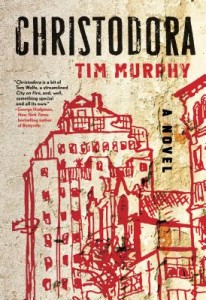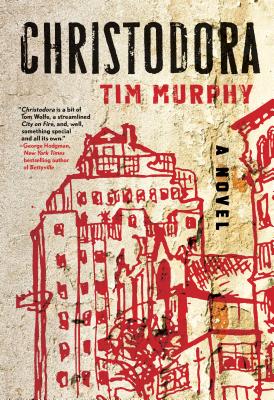 IN HIS THIRD NOVEL, Christodora, Tim Murphy describes an interconnected group of East Village residents who struggle with the AIDS epidemic over the course of a generation. His characters range from Jared and Milly, two privileged artists who adopt the son of a woman who died of AIDS, and Hector, a handsome Puerto Rican activist who battles with the aftereffects of survival, to Issy, a straight dental hygienist from Queens who becomes an iconic leader of gay rebels. Delving deep into the lives of caretakers, heroes, addicts, and survivors, Murphy records the huge emotional toll of the disease. Epic in scope, the novel explores issues of drugs, parenting, AIDS, gentrification, art, and survival.
IN HIS THIRD NOVEL, Christodora, Tim Murphy describes an interconnected group of East Village residents who struggle with the AIDS epidemic over the course of a generation. His characters range from Jared and Milly, two privileged artists who adopt the son of a woman who died of AIDS, and Hector, a handsome Puerto Rican activist who battles with the aftereffects of survival, to Issy, a straight dental hygienist from Queens who becomes an iconic leader of gay rebels. Delving deep into the lives of caretakers, heroes, addicts, and survivors, Murphy records the huge emotional toll of the disease. Epic in scope, the novel explores issues of drugs, parenting, AIDS, gentrification, art, and survival.
During the last twenty years, Tim Murphy has been a journalist reporting on hiv/aids issues and life in the East Village. He has worked as an editor and staff writer for POZ, Out, and The Advocate, and was nominated for a glaad Media Award for his New York magazine cover story on PrEP. He has also been a regular contributor on LGBT issues, pop culture, and the arts for The New York Times.
This interview was conducted by phone with Tim Murphy, who lives in Brooklyn.
Philip Pierce: Can you tell me how you came to write this book?
Tim Murphy: The book came about slowly. I had a real crash-and-burn around 9/11/2001—depression, drugs, HIV diagnosis. It lasted three and a half years, and when I came out of it—after reading voraciously all of my life—I just hated fiction. And finally, it was about 2009, I was living on my own again, a six-year relationship had just ended, and I just felt that I had to try to write fiction again, because I felt I would hate myself if I didn’t; I’d be bitter and regretful. But I didn’t really know what I would write about. I didn’t have a full blown idea. So I thought I would just write a short story or a novella. The story that came out of that was pretty similar to the first chapter of the book. And then I thought, maybe I’ll write a collection of short stories about New Yorkers who are in a state of stress or distress, like mental illness or one kind of drug addiction or another. I really liked it, jumping around in time, and then I put it together link by link.
PP: So it seems like the structure just came about organically, rather than planned.
TM: It really did. The first several chapters were just setting up different characters, and I felt that once they were introduced, it was just like looping back and digging deeper. Honestly, some key revelations in the book never even occurred to me until I was several chapters in. The two novels that I wrote in my twenties—I had outlined them from top to bottom and just stayed with that structure. This was much cooler than that, because I just set these people in motion and didn’t really know where it was all going. I remember vividly—I was running on the track in the East Village, and I thought, oh my god, what if Issy… Wait, if I say more, it’s going to be a spoiler!
PP: Right, say no more. The character of Issy was one of the most affecting for me. I cried reading about her, she was so fresh and open-hearted. Such an emotional journey!
TM: Yes, her character was one I really loved. All the characters are composites of people I know, and she’s like so many of the characters I interviewed and then became friends with.
PP: Did you ever cry when you were writing about her or some of the other characters?
TM: I did. When people ask me for writing advice, I always say, write the book you want to read. Turn yourself on, make yourself laugh, put yourself in suspense. I think in some weird way the whole formula for writing is so much easier that way. Rather than ask, “How am I going to present this to people,” it’s asking, “How am I going to satisfy myself?” I do think a lot of scenes in the book are like catharsis, wish fulfillment, or reconciliation that we don’t always get to have, or aren’t capable of initiating, in our own lives.
PP: Reconciliation was a central theme for Hector, the gay activist overwhelmed by grief. He was the mysterious link to many of the other characters in the book; I was fascinated by how this man became the person he was at the end.
TM: People have told me that they were in love with him. I’ve known a lot of guys like Hector—wonderful, beautiful, smart, passionate guys that were incredibly productive and effective but then fell apart. Yet some of them did make it, and survived. I dedicated the book to those guys.
PP: The novel covered so many issues—AIDS, cultural barriers in adoption, bipolar disease, political activism, depression. Did you have to do a lot of research to write it?
TM: I know, it’s a real grab bag of neurosis and pathologies. So much was based on my own life. I really struggled with mental illness. I had one episode of mania. It’s hard to know what it’s like if you haven’t had one. Also, I’ve lived here for 25 years, and I know so many people who struggled, got into crazy shit—not just gay men. New York is sort of a stage for mental illness and breakdowns—a crazy mix. I felt very loving toward the city; it’s sort of like a village where you see the same people every day, and your lives run over each other, and your foot traffic determines who become your closest friends.
PP: In your journalism you’ve been very open about your life. Writing about your affair with an older gay couple, drugs, addiction issues.
TM: I take the stuff from my life into my work. I really believe in the power of confessional writing. I don’t think you ever lose by exposing yourself and taking a risk. It’s so empowering to readers and helps other people lose their shame and stigma. When I was diagnosed with HIV and it all happened in the context of drug addiction and depression, I wasn’t forthcoming about that for many years. I didn’t want my extended family to know. But then, I just let all that go. And when I started doing that, so many HIV-positive people who had struggled with drug addiction said “Thank you so much.” I think over time the benefits of this kind of revelation outweigh the risk.
PP: You had written two earlier novels that were primarily gay and not well-known. This new novel centers on two heterosexual artists. Do you think that this had anything to do with the attention and critical praise this book has received?
TM: I do, actually. I think that was conscious on my part. I was afraid that if I wrote a book that was entirely in a queer world, it would just be ignored. This book has really struck a nerve among a lot of women—I presume hetero women. I was glad I did that. I’m very interested in how people regard the plight of others. All the characters are sort of windows onto the other characters. I was really into this idea of constantly flipping the point of view, like the camera is suddenly swinging around behind a character’s shoulder. That was really fun, and I really like that filmic kind of writing.
PP: Speaking of which, I was excited to read that Paramount TV has optioned your novel and that Ira Sachs, who directed Keep the Lights On, is one of the writers. Is he going to direct too?
TM: Yes. Ira is writing the pilot script now. And he’s such a great director. I’ve known him for the past several years. And after I saw his film Love is Strange, I thought, if Christodora was ever to be a miniseries or a movie, this is how I’d like it to feel—really intimate and like a casual camera. I think it’s very French: the observing camera. So I asked Ira to read it, and he did, and I was so delighted when he said he was really into it. That started the whole process of how it got to Paramount. I’d love to see what they do with it.
PP: How great. Not every novelist gets to pick his own director! Are you working on another novel now?
TM: Yes, there’s another book I’ve been working on pretty much until the election came along. It’s very different, it’s not about AIDS, and it’s very familial and generational. It’s where family and politics intersect. But I’m a journalist and an activist too, and this felt like a time to take action. The ACT UP people are working on Trump resistance, and I’m looking to find ways to work with different coalitions to face the giant threats that are coming.
PP: Were you surprised by the success of Christodora?
TM: As I was writing it, I was thinking, “Oh my god, I’ll be lucky if some small gay press picks it up because it’s so graphic.” But I didn’t want to hedge from the grief and rawness. I didn’t think a publisher as big as Grove would buy it. The reception has helped me see the novel more clearly in that I had so much focused on the dark side of the book. Many reviews have focused on the comedy and how moving it was.
Christodora is coming out in paperback in June of this year and also coming out in the UK and the French-speaking world. I’d really love to see the book get picked up by universities, and I could come speak about it. I’d love to teach at a college. Maybe readers could follow my twitter, TimMurphyNYC, and let me know about any schools that might be looking.
Philip Pierce, PhD, is a clinical psychologist and a lecturer at UCLA. He is also the writer/producer of the film Boy Culture.





